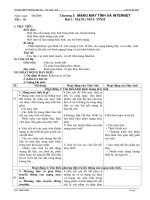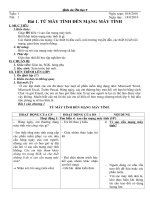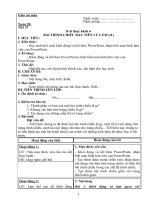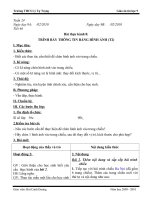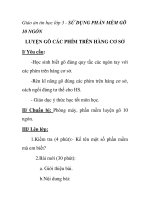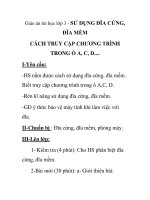- Trang chủ >>
- Tuyển sinh lớp 10 >>
- Toán
hoi an tin học 9 nguyễn xuân dũng thư viện tư liệu giáo dục
Bạn đang xem bản rút gọn của tài liệu. Xem và tải ngay bản đầy đủ của tài liệu tại đây (255.09 KB, 16 trang )
<span class='text_page_counter'>(1)</span><div class='page_container' data-page=1>
Week 4
Period: 7
UNIT 2 :
<b> LESSON ONE : </b>
<b> </b>
* AIM : Reading about “Ao dai” the traditional dress of Vietnamese people .
* OBJECTIVE :By the end of the lesson , students will be able to know more about “Ao dai” the traditional
dress of Vietnamese people .
* SKILLS : Listening – Speaking – Reading .
* TEACHING AIDS : Pictures , posters , cues
* PROCEDURE:
<b>T</b> <b>CONTENT</b> <b>TEACHER’S ACTIVITIES</b> <b>STUDENTS’ ACTIVITIES</b>
5’
20’
<i>I . WARM UP</i>
A
Picture d
Picture a
Picture f
Picture b
B
Vietnam
Japan
India
The USA
<i>II . PRE reading</i>
<i>1. Pre teach vocabulary</i>
1 . a túnic: tà áo
2 . a sýmbol: biểu tượng
3 . (to) slít: xẻ
4 . an éthnic minórity: dân tộc thiểu số
<i>2.Checking memory:ROR</i>
<i>3.Set the scene </i>
<i> <b>Chatting</b></i>
<i>4. Pre- reading</i>
T/F Prediction
1 . The “Ao dai” is the traditional dress
of Japan .
2 . It has been mentioned in poems ,
- Setting up the activities
- Asking Ss to match the
pictures to the countries
- Giving examples
-Beginning the new lesson.
- Eliciting <sub></sub> modelling <sub></sub>
Checking : meaning ,
pronunciation
What are they?
What ‘s it in Vietnamese?
What’s it in Vietnamese?
They are Muong, Thai,
Khmer. Who are they?
- Asking ss to copy them into
notebooks.
Checking memory
- Setting up the scene
- Making situations to
introduce a new lesson by
asking Ss some questions :
*Do you wear uniform when
you go to school ?
*What clothes do the school
girls wear ? Why?
“Aodai is the traditional
dress”
- Asking Ss to guess which
sentences are T and which
-Listening and carrying out
the activity.
Taking part in the
activities in groups
- Listening and repeating in
chorus <sub></sub> individually
They are tunics
It means “biểu tượng”
It means “xẻ”
They are ethnic minorities
- Copying them into
notebooks.
Taking part in the act.
- Listening and taking part
in building the new lesson
By answering the questions
*Yes
*Aodai
</div>
<span class='text_page_counter'>(2)</span><div class='page_container' data-page=2>
10’
8’
2’
songs , novels .
3 . nowadays , all Vietnamese people
like to wear “Ao dai” at work .
4 . The “Ao dai” is modernized by
fashion designers .
5 . The “Ao dai” is both traditional and
fashionable .
<i>4.Listen and check </i>
1-F 2-T 3-F 4-T 5-T
<i>5.Listen and repeat</i>
<i>III . while reading</i>
Questions
1 . Who used to wear “Ao dai” by
tradition ?
2 . Why do the majority of Vietnamese
women prefer to wear modern clothing
at work these days ?
3 . Do women usually wear the “Ao
dai” on special occasions nowadays?
4 . What have fashion designers done to
modernize the “Ao dai” ?
5 . Is the “Ao dai” a traditional dress of
Vietnam ?
<i>IV . Post reading</i>
Gap fill (the Exercise a , Page 14)
Answer :
1 . poems , novels , songs
2 . a long silk tunic with slits up the
sides worn over loose plants
3 . to wear modern clothing at work .
4 . lines of poetry on it .
5 . symbols
<i>V . HOMEWORK</i>
Write it up
Ex : “Ao dai” is a traditional dress of
the Vietnamese . ……”
sentences are F
- Monitoring and assisting
- Asking Ss to write their
guessing on the board
- Asking Ss to listen to the
tape and check what they
guess
- Asking Ss to listen and
repeat
- Asking Ss to read the text
again and answer the
questions
- Monitoring and assisting ss
- Correcting and evaluating
Asking students to ask and
answer the questions
- Asking Ss to do the exercise
a on Page 14
- Monitoring and assisting
-Correcting and giving
feedback
- Asking Ss to write 5
sentences about “Ao dai’
-Moddeling
-Checking understanding
- Listening and checking
- Listening and repeating in
chorus
-Reading the text carefully
- Doing the exercises in
groups
-Playing the game: Lucky
numbers
Practicing speaking in pairs
- Listening to the
information and carrying
out the act.
Doing the exercises in
groups
-Listening to the teacher
and
</div>
<span class='text_page_counter'>(3)</span><div class='page_container' data-page=3>
Week 4
Period: 8
UNIT 2 :
<i> </i>
<i> </i>
LESSON TWO :
* AIM : Practice speaking about personal preferences of clothing .
* OBJECTIVE :By the end of the lesson , students will be able to ask and answer about preferences of
clothing fluently .
* SKILLS : Speaking – Listening .
* TEACHING AIDS<i> :</i> Pictures , posters .
* PROCEDURE:
<b>T</b> <b>CONTENT</b> <b>TEACHER’S ACTIVITIES</b> <b>STUDENTS’ ACTIVITIES</b>
5’
15’
15’
<i>I . WARM UP</i>
<i>Kim’s game</i>
Blouse , T-shirt , sweater , jeans ,
trousers , shorts , suit , skirt , pants , …
<i>II . PRE speaking</i>
<i>1.Pre-teach vocabulary</i>
1 .plain(adj):đơn giản, rõ rệt,trơn
2 . plaid(adj): có kẻ ô vuông
3 . sléeveless(adj): không có tay
4 . bággy(adj): rộng thùng thình
<i>2.Checking memory:Matching</i>
<i>3.Set the scene</i>
<i> </i><b>Chatting</b>
III . while speaking
<i>Questions</i>
1 . What do you usually wear on the
weekend ?
- Setting up the activities
- Asking Ss to Ss to look at the
poster and try to remember the
words , then hiding the poster
and asking Ss to go to the
board to write them again
- Monitoring and assisting
- Eliciting <sub></sub> modelling <sub></sub>
Checking : meaning ,
pronunciation
How is the suit? Is it plain?
What kind of shirt is this?
How is this jumper?
Are they paggy pants?
Asking ss to copy the new
words into notebooks.
- Asking students to match the
pictures to the phrases
- Setting up the scene
- Making situation to introduce
new lesson by asking Ss some
questions
* What kind of clothes do you
wear to school ?
* What kind of clothes do you
like to wear ?
Giving instructions
- Hanging the poster on the
board and eliciting it
- Reading and trying to
remember
- Going to the board and
writing them again (one
student one word , step by
step) in 2 groups
- Listening and repeating in
chorus <sub></sub> individually
It’s plain
It’s plaid
It’s sleeveless
Yes , they are .
- Copying them into
notebooks
-Matching the pictures to
the phrases in individually
- Listening and taking part
in building the new lesson
*uniform
*trousers ,…
</div>
<span class='text_page_counter'>(4)</span><div class='page_container' data-page=4>
8’
2’
2 . What is your favourite type of
clothing ?
3 . Is it comfortable ?
4 . What color is it ?
5 . What would you wear to the party ?
6 . What type of clothing do you wear
on Tet holiday ?
<i>IV . Post speaking</i>
Report your answers again
Ex : Hello . My name is Toan . I
usually wear trousers and ashirt at
weekend . …
<i>V . HOMEWORK</i>
Write about Jane (Page 8) in
the notebooks
Ex : This is Jane ……
- Asking Ss to answer the
questions
- Asking Ss to ask and answer
(open pairs)
- Asking Ss to practise
speaking in pairs (closed pairs)
- Monitoring and assisting
- Correcting and evaluating
- Giving instructions
- Asking Ss to report their
answers again
- Giving examples
- Monitoring and assisting
- Correcting and giving
feedback
- Write some sentences about
your favourite clothing
- Giving examples
- Checking comprehension
- Practising speaking in
pairs
-Listening and carrying out
the activity.
Reporting in front of the
class in individually.
- Listening and Taking notes
into notebooks and doing it
at home.
</div>
<span class='text_page_counter'>(5)</span><div class='page_container' data-page=5>
Period: 9
UNIT 2 :
LESSON THREE :
* AIM : Listening for details to recognize a public announcement .
* OBJECTIVE :By the end of the lesson , students will be able to grasp the information correctly.
* SKILLS : Listening – speaking .
* TEACHING AIDS : Pictures , posters .
* PROCEDURE:
<b>T</b> <b>CONTENT</b> <b>TEACHER’S ACTIVITIES</b> <b>STUDENTS’ ACTIVITIES</b>
5’
15’
15’
<i>I . WARM UP</i>
<i>Bingo</i>
Blouse , T-shirt , sweater , jeans , trousers
, shorts , suit , skirt , pants , …
<i>II . PRE listening</i>
<i>1.Set the scene</i>
Fair
<i>2. Pre- listening:</i>
Hair Trousers Shoes shirt
long
black ………
<i>III . while listening</i>
<i>1.Check pre listening task</i>
<i>2.Listen and check the letters of the </i>
<i>correct pictures .</i>
a – B
b – A
- Setting up the activities
- Asking Ss to write down
five types of clothing they
like from the board.
- Saying out the words
- Beginning the task
- Setting up the scene
- Making situation to
introduce new lesson by
asking :
*What is this ?
*Who is this ?
*Where is she ?
”Mary is lost at the fair”
Giving instructions
- Asking Ss to guess the
characters of Mary to find
her
- Giving examples
Monitoring and assisting ss
- Asking Ss to listen to the
tape and check pre
-listening task (1-2 times)
- Giving instructions
- Running through the
pictures on page 9 .
Listening and carrying out
the activity.
Making the stick
Being the winner if you
have the first five stick.
- Listening and answering
to take part in building the
new lesson
*a fair
*Mary
*at a fair
- Listening and Guessing in
individually- share pair-
share groups
- Listening and checking
- Listening and doing the
exercise (individually <sub></sub>
comparing)
</div>
<span class='text_page_counter'>(6)</span><div class='page_container' data-page=6>
8’
2’
c – C
<i>IV . Post listening</i>
Describe one of your classmates
Ex : This is a boy . He is wearing
black trousers . …….
Who is he?
<i>V . HOMEWORK</i>
Describe your parents
Ex : This is my father . He is tall and
thin. He is forty years old. He is a
teacher ….
- Asking Ss to listen to the
tape twice and do the
exercise - Giving examples
- Monitoring and assisting
- Correcting and evaluating
- Asking Ss to describe one
of their classmates
- Giving examples
- Monitoring and assisting
- Correcting and giving
feedback
- Asking Ss to describe
their parents
- Giving examples
- Checking comprehension
Listening and carrying out
the act .
Describing the others in
groups
-Listening and taking notes
and doing it at home.
</div>
<span class='text_page_counter'>(7)</span><div class='page_container' data-page=7>
Period: 10
UNIT 2 :
<i> </i>
<b>LESSON FOUR : </b>
* AIM : Reading for details about “Jeans” .
* OBJECTIVE :By the end of the lesson , students will be able to know more about “Jeans” .
* SKILLS : Reading - Writing .
* TEACHING AIDS : Pictures , posters .
* PROCEDURE:
<b>T</b> <b>CONTENT</b> <b>TEACHER’S ACTIVITIES</b> <b>STUDENTS’ ACTIVITIES</b>
5’
15’
<i>I . WARM UP</i>
<i>Jumbled words</i>
Cotton - ttonco
Designer - nersigde
Fashion - onshifa
Cheaper - pereach
Material - rialtema
<i>II . PRE reading</i>
<i>1.Preteach vocabulary</i>
1 . (to) embróider: thêu
2 . a lábel: nhãn hiệu
3 . generátion(unc.n): thế hệ
<i>2.Checking memory .</i> What and where
<i>3.Set the scene</i>
4. <i>Pre- reading</i>
<i>Open Prediction</i>
1 . When did Jeans appear for the first
time ?
- Setting up the activities
- Asking Ss to go to the board
and write down the correct
words
- Giving examples
- Beginning the task
- Eliciting <sub></sub> modelling <sub></sub>
checking meaning ,
pronunciation
What’s it? What did they do
on the blouse?
Omo, Nokia, Sunlight... What
are they?
What does it mean in
Vietnamese?
- Asking ss to copy them into
notebooks.
Checking memory
- Setting up the scene
- Making situation to
introduce new lesson by
using pictures :
*Who is this ?
* What is he wearing ?
“Jeans are very popular
nowadays . Many young
people wear them”
- Asking Ss to guess the
answers
-Eliciting the answers
Listening and carrying
out the activity.
Going to the board and
writing in 2 groups
- Listening and repeating
in chorus <sub></sub> individually
They embroidered the
flowers.
They are labels
It means “thế hệ”
Copying them into
notebooks.
Listening and carrying out
the activity in individually
- Listening and answering
to take part in building
the new lesson
*Tom
*jeans
</div>
<span class='text_page_counter'>(8)</span><div class='page_container' data-page=8>
15’
8’
2’
2 . What are jeans made from ?
<i>III . while reading</i>
<i>1.Check pre reading task</i>
1 . 18th<sub> century </sub>
2 . the material called jean
<i>2.Questions</i>
( Exercise b ,Page 18)
1 . The word jean comes from a kind of
material that was made in Europe .
2 . The 1960s’ fashions were embroidered
jeans , painted jeans and so on .
3 . Because jeans became cheaper .
4 . Jeans at last became high fashion
clothing in the 1980s .
5 . The sale of jeans stopped growing
because the worldwide economic
situation got worse in the 1990s .
<i>IV . Post READING</i>
Fill in the table with the right
information about Jeans (Page 17)
.
<i>Answer :</i>
1 . 18th<sub> century - jean clothes</sub>
2 . 1960s - students
3 . 1970s - cheaper
4 . 1980s - fashion
5 . 1990 - sale
<i>V . HOMEWORK</i>
Write what you know about Jeans
Ex : Jeans appeared in the 18th<sub> century</sub>
…….
-Giving instructions
- Asking Ss to read the text
and check pre reading task
- Monitoring and assisting ss
- Correcting
- Giving instructions
-Asking Ss to read the text
again and answer the
questions
- Monitoring and assisting
- Correcting and evaluating
-Giving instructions.
- Asking Ss to remember
about the text to fill in the
sentences with the correct
information
- Giving examples
- Monitoring and assisting
- Correcting and feeding
back
- Asking Ss to write some
sentences about Jeans
- Giving examples
-Listening and carrying
the act.
-Reading and checking
the answers in groups
A,B
- Reading and answering
the questions
(individually <sub></sub> comparing)
-Playing the game Lucky
numbers
-Listening to the
information.
- Filling in the sentences
in groups ( closed books)
Listening to the
information.
-Taking notes and doing
it at home.
Week:6
</div>
<span class='text_page_counter'>(9)</span><div class='page_container' data-page=9>
<b> LESSON FIVE</b>
<b> : </b>
* AIM : Writing an argument paragraph .
* OBJECTIVE :By the end of the lesson , students will be able to write an argument paragraph about
clothes at the secondary school .
* SKILLS : Writing – Reading
* TEACHING AIDS : Pictures , posters .
*PROCEDURE:
<b>T</b> <b>CONTENT</b> <b>TEACHER’S ACTIVITIES</b> <b>STUDENTS’ ACTIVITIES</b>
5’
15’
13’
<i>I . WARM UP</i>
<b>Matching</b>
Introduction I think
……
Series of
arguments
Conclusion
<b>Words :</b> My opinion is , I think , Firstly ,
Secondly , Thirdly , Therefore , in
conclusion .
<i>II . PRE writing</i>
<i>1.Set the scene</i>
<i> </i>Chatting
<i>2. Pre_ wrting:</i>
1 . Is it necessary for secondary school
students to wear uniform at school ?
2 . Does it encourage students to be proud
of being students in their school ?
3 . Does it make students confident?
4 . Should students wear it at school ?
<i>III . while writing</i>
<b>Suggested questions</b>
1 . What is your opinion about wearing
casual clothes ?
2 . How do students feel when they wear
them?
3 . Can they give Ss freedom ?
4 . What do you think about your school
- Setting up the activities
- Asking Ss to put the
conjunctive words in the
correct rows
- Giving examples
- Beginning the task
- Presenting the new lesson
by asking Ss to answer
some questions :
Do you wear uniform now ?
*What do you think about
it?
- Asking Ss to look at the
text on Page 18 ,19 and
answer the questions
- Monitoring and assisting
- Correcting and evaluating
- Asking Ss to discuss the
suggested questions in
groups and write the other
paragraph
- Giving examples
- Monitoring and assisting
Listening and carrying
out the activity.
Taking part in the
activities in groups (Red
– White)
- Listening and answering
to take part in building
the new lesson
* Yes
*beautiful ,….
- Listening and answering
the questions individually
</div>
<span class='text_page_counter'>(10)</span><div class='page_container' data-page=10>
10’
2’
when you wear casual clothes ?
Ex : <i>I think secondary school students </i>
<i>should wear casual clothes ……….</i>
<i>IV . Post writing</i>
Correction of the letter
<i>V . HOMEWORK</i>
Write it up
Ex : I think ……
Giving instructions
- Asking Ss to write their
paragraph on the board
- Correcting and giving
feedback
- Asking Ss to write the
paragraph in their
notebooks at home
- Giving examples
Asking them to prepare:LF
- Checking comprehension
Listening to the
introduction
- Correcting the mistakes.
-Listening to the
information
- Doing it at home.
Week:6
</div>
<span class='text_page_counter'>(11)</span><div class='page_container' data-page=11>
<b> LESSON SIX : </b>
* AIM : Further practice the present perfect tense and the passive voice .
* OBJECTIVE :By the end of the lesson , students will be able to use the present perfect tense and the
passive voice form accurately .
* SKILLS : Reading – Writing .
* TEACHING AIDS<i> :</i> Pictures , posters , Cues .
* PROCEDURE:
<b>T</b> <b>CONTENT</b> <b>TEACHER’S ACTIVITIES</b> <b>STUDENTS’ ACTIVITIES</b>
5’
20’
<i>I . WARM UP</i>
Pelmanism
do make find be
eat go made been
gone found eaten done
<i>II . activity one (present perfect)</i>
<i>1 . Rub out and remember (LF1)</i>
Nga : Come and see my photo .
My : Lovely ! Who is this girl ?
Nga : It is Lan , my friend .
My : How long have you know her?
Nga : I have known her for 6 years .
My : Have you seen her recently ?
Nga : No , I haven’t seen her since
2003 <b>.</b>
<i>2. Check concept</i>
since + the point of time
for + a period of time
<i>3 . Practice</i>
- Setting up the activities
- Asking Ss to choose the
suitable words
- Giving examples
- Monitoring and assisting
- Beginning the task
-Giving instructions
- Presenting the lesson by
drawing pictures :
*Who are they ?
*What are they talking about ?
“Nga and My are watching the
photo album .”
- Writing the dialogue on the
board and asking Ss to look at
the dialogue on the board <sub></sub> Rub
out and remember
- Modelling
- Monitoring and assisting
- Correcting and evaluating
- Asking Ss about the tense of
the sentences
- Asking about the form and
the using
- Giving instructions.
Listening and carrying out
the activity.
Taking part in the activities
in groups
- Listening and taking part
in building the lesson
-Nga and My.
- Listening and repeating in
group <sub></sub> individually
- Practising speaking in
pairs (open <sub></sub> closed pairs)
-*Using the present simple
tense
-stating the form , use.
-Listening and answering
</div>
<span class='text_page_counter'>(12)</span><div class='page_container' data-page=12>
---18’
2’
<i>III . activity two(passive form)</i>
<i>1. Presentation </i>
They grow rice in tropical countries
Rice <b>is grown</b> in tropical countries .
<i>2.Practice (a,c,d of LF4 and a,b,c</i>
<i>of LF5)</i>
1 . Jean cloth was made completely
from cotton in the 18th<sub> century .</sub>
2 . Five million bottles of champagne
will be produced in France next year .
3 . A new style of jeans have just
been introduced in the USA .
4 . The problem can be solved by us
5 . Experiments should be stopped on
animals .
Life may be found on another planet
by us .
<i>V . HOMEWORK</i>
Do the exercises (LF2,3)
Ex : 1 . Have you ever seen Giac
Lam pagoda ?
- Yes , I have already seen
it .
- Hanging the poster of LF1 on
the board and eliciting the
poster (Page 20)
- Running through the poster
- Asking Ss to make similar
dialogue
- Giving examples/modelling
- Monitoring and assisting
- Correcting and evaluating
- Presenting the lesson by
giving the example
- Asking Ss about the concepts
: meaning ,form ,use
- Hanging the poster on the
board , and eliciting a poster
- Asking Ss to write the second
sentences having the same
meaning as the first sentences
- Giving examples
- Monitoring and assisting
- Correcting
Setting tasks for ss to do at
home.
- Asking Ss to do the exercises
(LF2,3)
- Giving examples
-Asking ss to review the
lessons and do all the
exercises in the exercise book
to do the test.
- Checking comprehension
- Practising speaking in
pairs
- Doing the exercises in
group
(Lucky Numbers)
Carrying out the exercises
in groups
- Looking at the board and
doing the exercises
individually
Listening to the information
-Taking notes into
notebooks
-Carrying out the activities
at home
</div>
<span class='text_page_counter'>(13)</span><div class='page_container' data-page=13>
UNIT 2:
I. AIMS :
Ask and respond to questions on personal preferences
Ask for and give information
Write a exposition
Revision of the present perfect tense and its passive voice.
II. OBJECTIVES :
By the end of the lessons, students will be able to ask and respond to questions
on personal preferences, ask for and give information, write an exposition and
reviewing of the present perfect tense and its passive voice.
III. SKILLS:
Listening, speaking, reading, writing
IV. TEACHING AIDS :
Pictures of unit 2, posters, colorful chalks
V. PERIODS :
7. Getting started-Listen and read
8. Speak
9. Listen
10.Read
11. Write
12. Language focus
</div>
<span class='text_page_counter'>(14)</span><div class='page_container' data-page=14>
Period 13
<i>1.</i> <i>Aim: </i>Reviewing the units from unit 1 to unit 2
<i>2.</i> <i>Objective: </i>By the end of the test, students will be able to remember the old knowledges and use them
exactly.
<i>3.</i> <i>Skills:</i> Multiple choice with Listening, reading, grammars, vocabulary, structures....
<i>4.</i> <i>Teaching aids: </i>Papers
<i>5.</i> <i>Content: </i>
1.The “ao dai” is the traditional dress of ………women.
a.Vietnamese b.Japanese c.Chinese d.Thais.
2.Who used to ………..the “ao dai” by tradition?
a.to wear b.wear c. wore d.wearing
3.In the 18th<sub> century jean cloth was made completely from ……….. .</sub>
a.nylon b.silk c.cotton d.leaves
4.. The exercise must be ……….. carefully.
a.do b. did c. done d. doing
5.Jeans are sold all ………the world .
a. on b. at c. over d. in
6……….. is the highest towers in the world.
a.Petronas b.. Sear c. Eiffel d.Everest
7. I / not see / him / yet.
a. I haven’t seen him yet b. I hasn’t seen him yet c. I didnot see him yet d. I saw not him yet.
8. <i>Choose the word or phrase that are not correct in Standard English</i>.
When she came, I read her letter.
A B C D
9. <i>Choose the word or phrase that are not correct in Standard English</i>.
It is used to be easy to park in the city center.
A B C D
10.What clothes do you wear to school everyday?
a. jeansb. faded jeans c.white shirt & black pants d. blouses
11.A lot ……….. university & college students wore jeans.
a. without b.to c. for d. of
12.In the 1980s jeans finally became high ………..clothing.
a. fashion b. fashionable c.unfashionable d. fashionably
13.Today young ………is still fond of wearing jeans .
a.generation b. generating c. generate d. to generate
14.Lan ……… that book yesterday.
a.buy b. bought c. has bought d. buying
15.They wish they………richer next time.
a. would b.would be c. will be d. get
* <i>Choose the word which is pronounced differently from the others.</i>
</div>
<span class='text_page_counter'>(15)</span><div class='page_container' data-page=15>
* <i>Choose the word whose main stress is placed differently from the other</i>s.
18. a. inspire b. fashion c. embroider d. design
19. a. tradition b. separate c. clothing d. temple
20. I’m sorry. I can’t go to the party.
a. I wish I can go to the party. b. I wish I could go to the party.
c. I wish I couldn’t go to the party. d. I wish I go to the party.
* <i>Choose the word(a,b,c or d) that best fits each of the blank spaces.</i>
In the Victorian(21)...men still wore frock coats but, for less formal occassions, changed(22)...short
lounging jackets worn with narrow trousers anda bow tie. (23)...women, full dresses came back(24)...fashion,
held out from the body by the criniline(=a frame worn under the skirt). These were(25)...replaced(26)...the
bustle, a padded roll wrapped around the hips. Towards (27)...end of the (28)...women began wearing narrower
skirts and two –piece(29)...with corsets. They wore caps(30)...and bonnets outside. Victorian(adj): thuộc
thời đại Nữ hoàng Victoria (1837- 1901)
21. a. century b. decade c. empire d. period
22. a. into b.for c. at d. to
23. a. for b.with c. as d. according to
24. a. to b. into c. off d. for
25. a. later b. lately c. latestd. late
26. a. for b. with c. by d. to
27. a. a b. an c. the d. no article
28. a. decade b. century c. period d. empire
29. a. cloths b. costumes c. cuctomers d. shirts
30. a. indoor b. inside c. indoors d. outdoor
* <i>Listen and write True(T) or False(F) for the statement about the passage.</i>
31...A four-year-old boy is reported missing.
32...He was lost near the entrance to Dam Sen Park.
33. ...He’s wearing blue trousers, a short-sleeved shirt and black shoes.
34...If you see the lost boy, please bring him to the Gate Two.
35...The boy’s grandmother is waiting for him at Gate One
* <i>Listen and complete the conversation</i>:
Mike: Susan,let me introduce you to Yoko. She’s
studying English here in London.
Susan: Hello, (36)...
Yoko: Pleased to meet you, too.
Susan: (37)...
Yoko: I’m from Japan.
Susan: (38)...
Yoko: I’m studying English here because I need
it for my job.
Susan: Really? So, (39)...?
Yoko: I work for an international bank in Tokyo.
Susan: Oh, I see. (40)...
THE KEY OF THE FIRST TEST ENGLISH 9
1a 2b 3c 4c 5c 6a 7a 8c
A: Bye.
B: Pleased to meet you, Yoko
C: Why are you learning English
here?
</div>
<span class='text_page_counter'>(16)</span><div class='page_container' data-page=16>
9a 10c 11d 12a 13a 14b 15b 16b
17b 18b 19a 20b 21d 22a 23a 24b
25a 26c 27c 28c 29b 30c 31F 32T
33T 34F 35F 36B 37D 38C 39E 40A
<i>Tapescript 1</i>:
A little boy is reported missing. He was last seen ten minutes ago near the entrance to Dam Sen Park. His name’s
Nam and he is three years old. He has dark, short hair, he’s wearing blue pants, a short-sleeved shirt and black
shoes. If you see Nam, please bring him to Gate One. His mother is waiting for him there. Thank you very much.
<i>Tapescript 2</i>:
Mike: Susan,let me introduce you to Yoko. She’s studying English here in London.
Susan: Hello, (36) Pleased to meet you, Yoko
Yoko: Pleased to meet you, too.
Susan: (37) Where are you from?
Yoko: I’m from Japan.
Susan: (38) Why are you learning English here?
Yoko: I’m studying English here because I need it for my job.
Susan: Really? So, (39) Who do you work for?
Yoko: I work for an international bank in Tokyo.
Susan: Oh, I see. Bye.
THỐNG KÊ CHẤT LƯỢNG
Lớp Sỉ số Trên 5 Tỉ lệ Dưới 5 Tỉ lệ
9/4 26 10 38,5% 16 61,5%
NHẬN XÉT
ƯU ĐIỂM
- Đa số học sinh có học bài và xem bài cu.õ
- Đa số làm đầy đủ các câu và không bỏ câu nào.
- Có đọc các bài khố kĩ để làm bài.
- Học sinh làm bài kiểm tra nghiêm túc không quay cóp coi bài của nhau.
- Đề kiểm tra vừa phải khơng q khó đối với học sinh.
- Đề có sự phân loại học sinh giỏi ,khá, trung bình , yếu, kém.
TỒN TẠI
- Các em chưa suy nghĩ kĩ đề bài và hấp tấp chọn các câu trắc nghiệm chưa đúng.
- Phần đọc hiểu đa số các em đọc chưa kĩ nội dung của bài chính vì thế mà các em chọn sai.
- Các em cịn tẩy xố trong bài quá nhiều đề nghị các em rút kinh nghiệm trong lần sau để bài làm được tốt hơn.
Một số bài đáng khen: 1. . Nguyễn Thị Hồng Thưởng
2. Trần Minh Trí.
- Bài làm đầy đủ tất cả các phần, sạch sẽ.
</div>
<!--links-->
